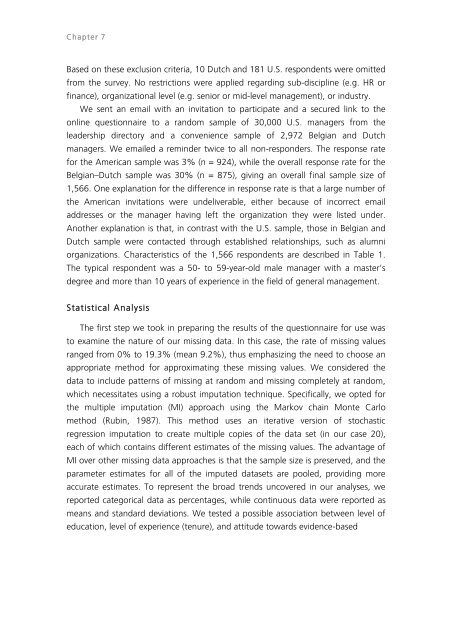In Search of Evidence
jqluvth
jqluvth
Create successful ePaper yourself
Turn your PDF publications into a flip-book with our unique Google optimized e-Paper software.
Chapter 7<br />
Based on these exclusion criteria, 10 Dutch and 181 U.S. respondents were omitted<br />
from the survey. No restrictions were applied regarding sub-discipline (e.g. HR or<br />
finance), organizational level (e.g. senior or mid-level management), or industry.<br />
We sent an email with an invitation to participate and a secured link to the<br />
online questionnaire to a random sample <strong>of</strong> 30,000 U.S. managers from the<br />
leadership directory and a convenience sample <strong>of</strong> 2,972 Belgian and Dutch<br />
managers. We emailed a reminder twice to all non-responders. The response rate<br />
for the American sample was 3% (n = 924), while the overall response rate for the<br />
Belgian—Dutch sample was 30% (n = 875), giving an overall final sample size <strong>of</strong><br />
1,566. One explanation for the difference in response rate is that a large number <strong>of</strong><br />
the American invitations were undeliverable, either because <strong>of</strong> incorrect email<br />
addresses or the manager having left the organization they were listed under.<br />
Another explanation is that, in contrast with the U.S. sample, those in Belgian and<br />
Dutch sample were contacted through established relationships, such as alumni<br />
organizations. Characteristics <strong>of</strong> the 1,566 respondents are described in Table 1.<br />
The typical respondent was a 50- to 59-year-old male manager with a master’s<br />
degree and more than 10 years <strong>of</strong> experience in the field <strong>of</strong> general management.<br />
Statistical Analysis<br />
The first step we took in preparing the results <strong>of</strong> the questionnaire for use was<br />
to examine the nature <strong>of</strong> our missing data. <strong>In</strong> this case, the rate <strong>of</strong> missing values<br />
ranged from 0% to 19.3% (mean 9.2%), thus emphasizing the need to choose an<br />
appropriate method for approximating these missing values. We considered the<br />
data to include patterns <strong>of</strong> missing at random and missing completely at random,<br />
which necessitates using a robust imputation technique. Specifically, we opted for<br />
the multiple imputation (MI) approach using the Markov chain Monte Carlo<br />
method (Rubin, 1987). This method uses an iterative version <strong>of</strong> stochastic<br />
regression imputation to create multiple copies <strong>of</strong> the data set (in our case 20),<br />
each <strong>of</strong> which contains different estimates <strong>of</strong> the missing values. The advantage <strong>of</strong><br />
MI over other missing data approaches is that the sample size is preserved, and the<br />
parameter estimates for all <strong>of</strong> the imputed datasets are pooled, providing more<br />
accurate estimates. To represent the broad trends uncovered in our analyses, we<br />
reported categorical data as percentages, while continuous data were reported as<br />
means and standard deviations. We tested a possible association between level <strong>of</strong><br />
education, level <strong>of</strong> experience (tenure), and attitude towards evidence-based


